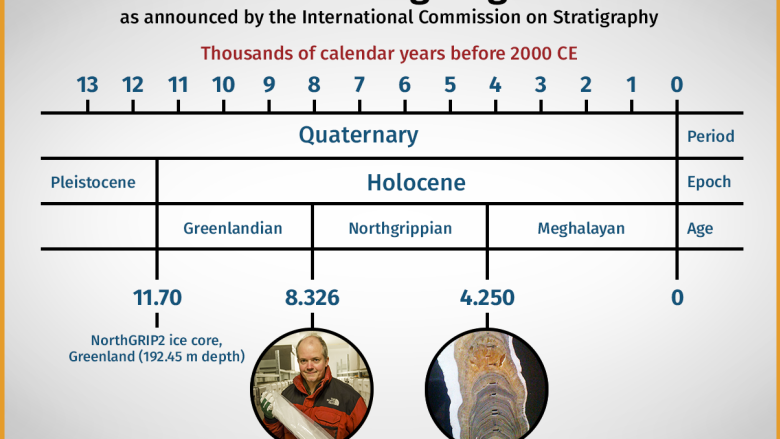You're living in a new geologic age, the Meghalayan

It's official — you're living in a new age.
It's called the Meghalayan, and it was officially added this week to the International Geologic Time Scale.
The scale divides the history of the Earth into eons, eras, periods, epochs and ages, the way we divide smaller increments of time into years, months, hours, minutes and seconds.
The update to the geologic time scale adds three new ages, subdividing the current Holocene epoch for the first time, into the:
-
Greenlandian (Early Holocene) Age, which began when a sudden warming 11,700 years ago ended the last ice age — and the Pleistocene Epoch.
-
Northgrippian (Middle Holocene) Age, which started 8,300 years ago.
-
Meghalayan (Late Holocene) Age, which runs from the start of a "mega-drought" 4,200 years ago to the present day.
The latest version of the geologic time scale was released on July 13 by the International Union of Geological Sciences, which is in charge of setting international standards in geology. The scientific details will be published later this year in the scientific journal Episodes.
Unique human impact?
The Meghalayan is unique, because it coincides not just with a global climatic event, but also widespread upheaval among human communities around the Mediterranean Sea, the Middle East and Asia — the collapse of civilizations and human migrations in Egypt, Greece, Syria, Palestine, Mesopotamia, the Indus Valley, and the Yangtze River Valley, reports the International Commission on Stratigraphy, which is in charge of standardizing the International Geologic Time Scale under the auspices of the Union of Geological Sciences.
Michael Walker, who chaired the working group of geologists that proposed the new ages, said not everyone agrees on the link between the mega-drought and events in human history, as there could be other reasons for the latter, such as socioeconomic factors.
"But it is curious that round about 4,200 years ago, just at the time when we've identified a significantly drier phase … we do find indications of societal collapse which could — and I say could — reflect aridification driving that collapse," said Walker, an emeritus professor of quaternary science at the University of Wales.
The Meghalayan is named for a stalagmite in a Mawmluh Cave in the northeast Indian state of Meghalaya that is used as the geologic standard that marks the exact start of the age. The stalagmite was deposited gradually from layers of minerals over thousands of years as rainwater dripped through the roof of the cave. The layers contain chemical signatures that show how levels of precipitation changed over time.
They show that around 4,200 years ago, it suddenly became much drier.
"It's almost as though the monsoon suddenly becomes much less effective in terms of precipitation delivery," Walker said.
The signature of that "mega-drought" is seen in many other parts of the world, although the climate blip resulted in extra precipitation rather than drought in some places. For example, Walker said, in Western Canada, an increase in snow caused glaciers to reform and readvance.
Similarly, the Greenlandian and Northgrippian ages are named for the NorthGRIP site in Greenland where ice cores were drilled that clearly show a sudden warming at the end of the last ice age and a sudden global cooling around 8,300 years ago caused by an influx of icy meltwater from continental ice sheets into the North Atlantic.
Martin Head, a geologist at Brock University in St. Catharines, Ont., and chair of the subcommission that oversaw Walker's working group said the Geological Time Scale is used primarily for communication about the timing of events by a wide range of scientists from geologists to archeologists. They had been informally dividing the Holocene into early, middle and late ages since the 1970s, but that caused confusion.
"One person's Early Holocene might be somebody else's Middle Holocene," he said.
It was problem Walker aimed to solve with a team of 11 other scientists, including two Canadians — University of New Brunswick ecologist Les Cwynar and University of Ottawa geologist David Fisher. They spent eight years trying to pin down exact dates that everyone could agree on, based on measurable signatures in a specific physical geological features.
Now that their recommendations have been approved, Walker said, "we're relieved."
Another working group under the International Commission on Stratigraphy has been working for years to add a new epoch after the Holocene called the Anthropocene, marked by major impacts of humans on the Earth's geology in the post-industrial age.
The group proposed in the journal Science in 2016 that it should begin around 1950 at a boundary marked by a layer of radioactive fallout from widespread nuclear testing.
If it happens, it would cut about 70 years off the end of the Holocene — and the Meghalayan age — but Walker says "it is in no way compromised by the subdivisions we've proposed."

